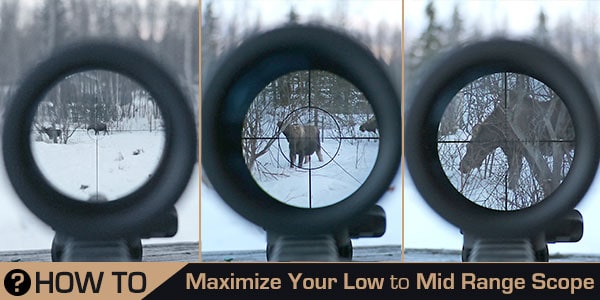 I was a sworn iron sight hunter. Growing up on a homestead in the wilderness of Alaska, I saw more hunters using iron sights than scopes. I watched my father down deer with iron sights at ranges most hunters with scopes would not have attempted.
I was a sworn iron sight hunter. Growing up on a homestead in the wilderness of Alaska, I saw more hunters using iron sights than scopes. I watched my father down deer with iron sights at ranges most hunters with scopes would not have attempted.
When I bought a rifle, my only upgrades were usually a sling and a receiver (peep) sight. I learned to be fast and accurate with iron sights of any type, and I have used iron sights to stop aggressive attacks from bear and moose within feet of my muzzle.
Iron sights are simple and effective. When used correctly they are fast and accurate. There is no magnification to get in the way of speed or target identification when close-range shots are necessary. They don’t fog and are usually not easily damaged. Sharpshooters in the Civil War were able to make constant hits on men out to ranges of 800 to 1200 yards with muzzle loaders and iron sights.
In the Army, I was introduced to reflex (red dot) sights. I was sold immediately. Reflex sights have most of the advantages of iron sights, and overcome most of the disadvantages of iron sights. I used them heavily in the Army, and have ever since. My .50 Beowulf bear defense carbine wears a reflex sight with iron sights for backup.
I also began, as a sniper, to rely heavily on magnified scopes. I had shot often with scopes, and had owned a few, but for the first time I really began to study and appreciate their correct use and advantages. What I used to do with Iron sights at long ranges, I could do better with a scope. What I couldn’t do with iron sights, I could do with a scope.
So, my options for hunting and other purposes became:
- Iron sights
- Reflex (red dot) sight
- Magnifier behind a reflex sight
- A magnified scope.
I used all of these options except for the magnifier – I used them on the range, but haven’t while hunting.

A US Optics 1-8x scope in a ZRO Delta DLOC mount is a compact rugged package that adds no unnecessary bulk to the rifle, but is as useful as a red dot sight at zero magnification, and has plenty of magnification at the top end to compete with traditional hunting scopes.
I didn’t have ZRO Delta DLOC return-to-zero mounts so using different sighting options meant either reconfiguring rifles between uses, or using different rifles for different purposes. This also meant that hunting between heavy brush and open tundra meant that I had a sighting system ideal for one but not the other, or sufficient for both but not ideal for either.
When using a 2.5-10x illuminated IOR scope with an MP8 reticle, which I used in Iraq and since, I discovered that with my 20″ match SPR-style rifle, the scope dialed down to 2.5x, I could run through a CQB course as fast and accurately as I could with my M4 and M68 (red dot). At that time, companies were introducing zero to low-magnification scopes in the 1 or 1.5 power at the low range, and these caught my interest. I also had an interest in IOR, since I was running one of their optics, and was intrigued to see that they were pioneering ever larger magnification ratios. 1-6x, 1-8x. Once they saw what had previously been considered impossible, other manufacturers began to follow with their own scopes. Today, the ratios have climbed to the 1-10x range in quality scopes.
I have recently spent some time hunting with a US Optics 1-8x scope. This scope is a good representative of the low-to-mid-magnification range scopes we are discussing, so I took some photos through it. Please note the difficulties of supporting a rifle and a camera, not to mention focusing both scope and camera to bring moving targets and the reticle into focus simultaneously… And consider the failure of local wildlife to fully understand the importance of cooperating. This led to some slightly imperfect photography and should not be seen as a reflection on the quality of the US Optics scope. This is a clear, bright, high-quality scope, and I used it on top of two different rifles to hunt in New Zealand.
From the beginning, I have been sold on the concept. Here’s why you should be too:
1. Hunting, like combat, is unpredictable. I once set out to hunt caribou at long range. Winds over 60 MPH prevented any long shots and I had to crawl up to within 100 meters to shoot one. Another time I had an ammunition malfunction. This forced me to leave my rifle behind, crawl up to within 75 meters of the herd, and shoot one with my pistol. I unexpectedly shot a charging moose at ten feet, and a bear at seven feet. I have been so close to Red Stag in New Zealand in such dense brush, that my magnified scope was all but useless to get on target quick enough. Even in open country, where visibility is basically unlimited, I have been startled to come upon game almost underfoot where I thought there was no place for an animal to hide.
On the other hand, even in the thickest brush, there are sometimes openings where a shot can be taken from one mountainside to the next, across a steep valley. There are rare occasions where the shot is not long, but the ability to identify and shoot between interposing brush and branches is vital. In almost every location I have hunted, both magnified scopes and reflex or iron sights would have been an advantage.
2. Most people need less magnification, not more. Most animals are shot at what I would consider close range – from point blank out to about 150 meters, sometimes 200. Most hunters do not take longer shots, either because they have not needed to, or because they want to be sure of humanely killing and recovering the animal. Too much magnification can be detrimental at the ranges where most animals are sighted and taken. I’ve heard many people tell of missing a shot on an animal because all they could see was hair and could not tell where on the animal they were aiming. I have experienced the same.
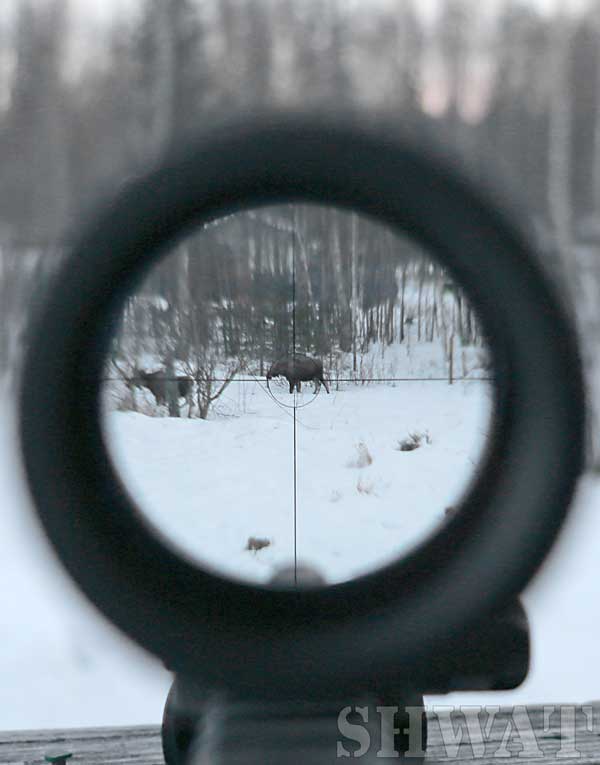
A moose seen through the US Optics scope at zero (1x) magnification. At this setting, the scope feels like a red dot sight in most ways, especially when illuminated.
3. The time available to identify, aim, and shoot at an animal is almost always directly related to how close the animal is. A deer or moose startled at 25 meters will require a quick decision, acquisition of the target, and shot, before the animal begins to move. The closer to the hunter the animal is, the faster it will move out and the more intent it will be to find concealment. When the animal is close, the shot has to be fast. Magnification is detrimental to speed in acquiring and aiming at the target.
On the other hand, an animal that is distant, even an animal that has detected the hunter, will usually take more time to investigate the hunter and his actions, and will move more casually. Animals are masters at conserving energy and will only move as fast as they feel is necessary. Sometimes the animal will simply remain alert and wait to see if the hunter approaches. A hunter will usually have more time to set up the shot if the animal is distant.
4. Carrying different sighting systems with quick-release mounts is not a good choice.
I know some hunters do it, but carrying multiple sights or scopes seems too complicated and fiddly to me. It also presents the possibility losing an expensive optic. If I were carrying different systems, I am certain I would not switch when I saw an animal, but would just go with whatever I had mounted.
So for close animals, do you want high magnification or no magnification? What about longer shots? What guarantees that you will be presented with only one or the other? The solution to these issues is the zero to mid-range magnification scope.
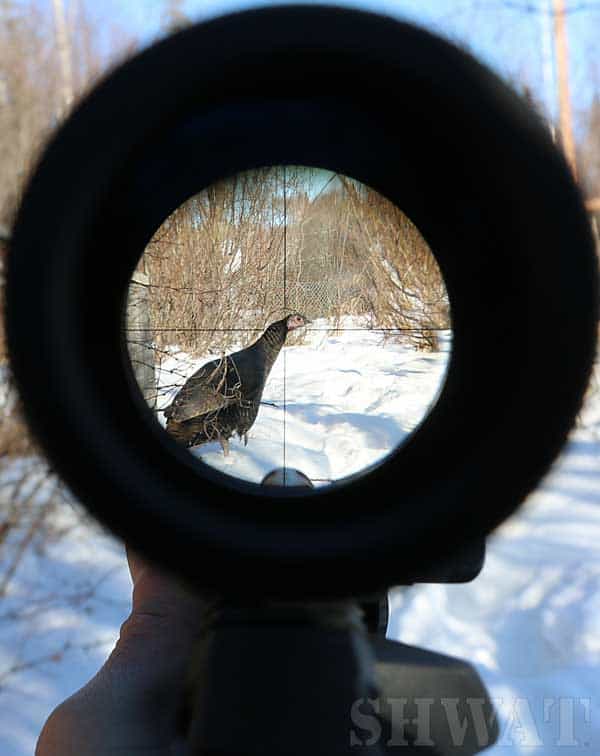
Zero (1x) Magnification gives an unobstructed, both eyes open view of the hunter’s surroundings, and allows speed in aiming and firing on close, fast-moving targets.
At the low end, there is little to no magnification, depending on the scope. When the scope is dialed down to zero power, like a red dot sight it does not obstruct your field of view and is just as fast to use. At it’s lowest magnification, it has most of the advantages of a red-dot sight over an iron sights. The only advantage a red dot sight gives is the limited parallax that is a feature in most of those sights. The scope requires more precise placement of the head, as iron sights do.
At the high end of the magnification range, the scope works just like a normal variable-power scope. This is self-explanatory. You have the magnification you need for more precise shot placement at longer ranges or on smaller targets. The magnification can also help if you are using a reticle to range the target.
This low to mid range magnification scope style is usually more compact and robustly built than many more traditional scopes. This means less chance of breaking on the hunt.
Eye relief is more forgiving at zero magnification that in most traditional hunting scopes. This also leads to faster shots at close range.
Installing a 1-6x or 1-10x scope on a rifle makes the firearm a true multi-purpose hunting rifle. I no longer must decide which rifle to take or whether to switch optics. I can use the same rifle on any hunt. It truly makes a rifle a grab-and-go tool.
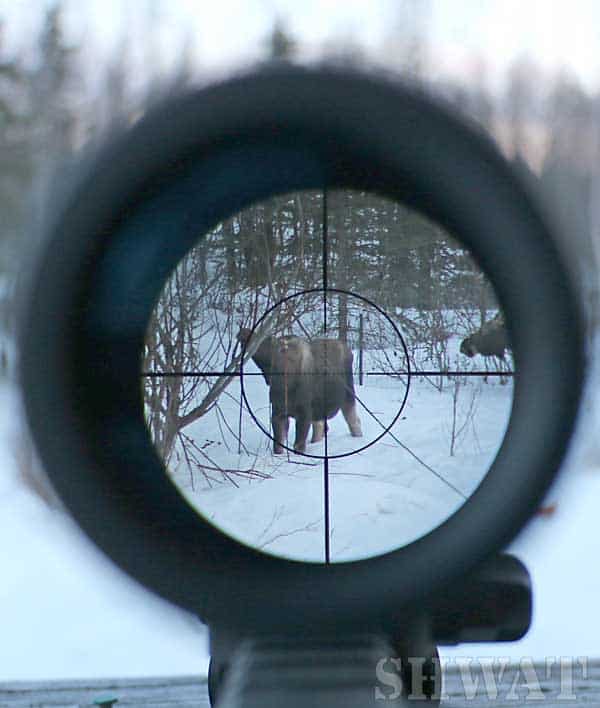
At four power, the moose is seen in better detail, but there is not too much magnification and you keep a reasonably wide field of view. This moose is too close to worry about ranging, but the reticle could be used to range a more distant target.
But! (There is always a “but”, isn’t there?)
As with any sighting system, you need to use it correctly to maximize the advantage.
1.) Choose a reticle that makes sense for your purpose and caliber. A ranging reticle only works if you know how to use it and if it is designed for ranging the appropriate target. On the other hand, if you will be using holdovers, as simple duplex will be a disadvantage.
2.) Mount the scope properly to avoid damage, avoid canting the scope, and to gain the correct eye relief and scope height. A scope mounted at the wrong height or with improper eye relief can cause you to miss targets, or at least shoot a lot slower than you could.
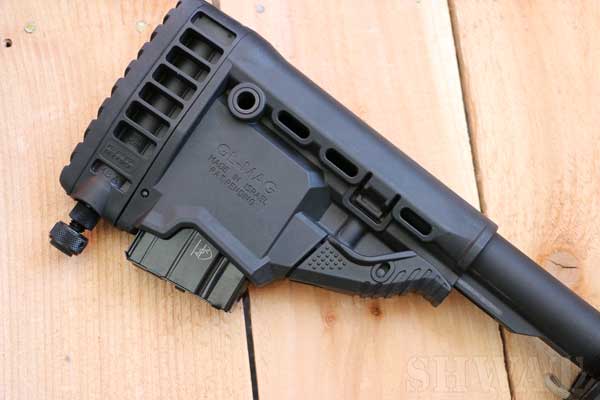
Correct eye relief is vital for speed and accuracy. I found that the scope and mount combination I was using did not give me quite enough eye relief on this rifle. There were several good solutions I could have used to fix this, but I chose to add the FAB Defense MBA monopod to my stock, which added just the needed length for the correct eye relief. I could have added a rail system with a top rail of the correct height to move the scope forward, or used an A2 stock.
3.) Carry the scope set to zero magnification. This is similar to hunting with a red dot. When you see a target, keep your head up and eyes focused on the target. Bring the rifle butt to your shoulder/chest and the stock to your cheek. Bring the rifle to your eye, not your eye to the rifle. As the rifle comes up, with both eyes open, you will see the reticle appear in your vision. Move the reticle to the target and fire.
You carry the scope set to zero magnification because when you are surprised by an animal at close range, you need to shoot quickly. When the animal is close you don’t have time to fiddle with magnification. While you are moving, you need to be ready for a snap shot. Even wide open terrain can conceal large game animals surprisingly close, and there is always a chance that you will walk right up on one before you see it.
If you are hunting dangerous game, or hunting in an area where you might have to defend yourself against a dangerous animal, keep your scope set on zero magnification. Again, you never know when you might need to snap a shot off in an instant.
4.) When you see a distant animal, need to range an animal with the reticle, or need more precision, dial the magnification up. More distant animals often give the hunter more time to set up a shot, so there is usually time to dial the magnification up. Using more magnification for ranging will allow more precise ranging. Magnification can also be helpful for placing a shot through brush without hitting a branch or twig.
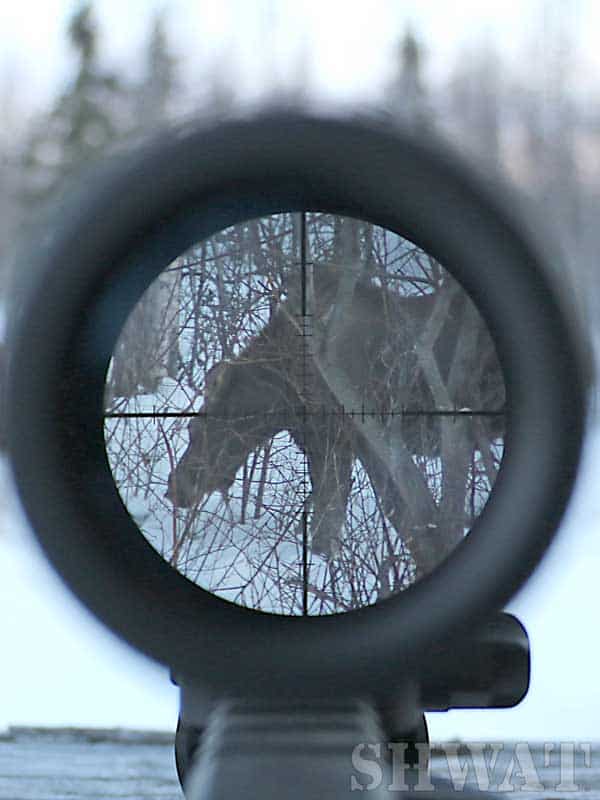
Even a close moose could require 8x magnification, if the shot needs to go between branches or brush. This view clearly shows where the willows might deflect a careless shot, and where the neck is exposed.
5.) Illumination is helpful, but set the illumination at the lowest level that still gives visibility of the reticle. Too bright a reticle lowers precision and can make small details harder to see through the scope. You should always be seeking to turn the brightness of the reticle down, not up.
6.) Practice, practice, practice. Practice until using that scope correctly until it is as reflexive as pointing your finger.
If used correctly, the zero-to-mid-range variable power scope can greatly increase your effectiveness. Compact, rugged, simple to use, and combining most advantages of red-dot sights with the advantages of magnified scopes, it can truly make the right rifle as close to an all-purpose firearm as you can get.
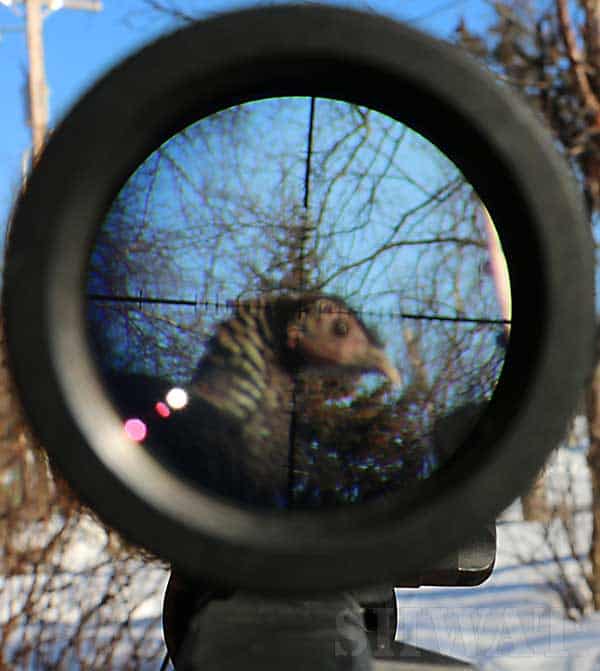
As the turkey moves away, no magnification is necessary, but at 8 power, this scope can give a hunter a closer look or better precision for a tiny target like a turkey’s neck.


30x magnification for $2-3000? I don”t shoot prairie dogs at 800 yds, so I guess I”ll pass! LOL!
Hi All im newbie here. Good article! Thx! Love your stories!